Expert Tips for Cleaning Goose Down Pillows
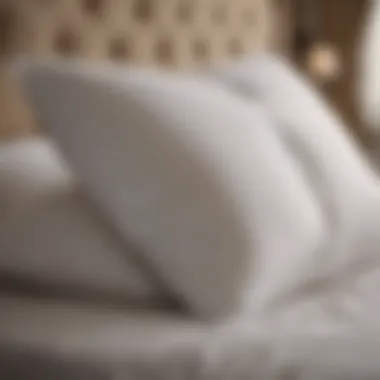
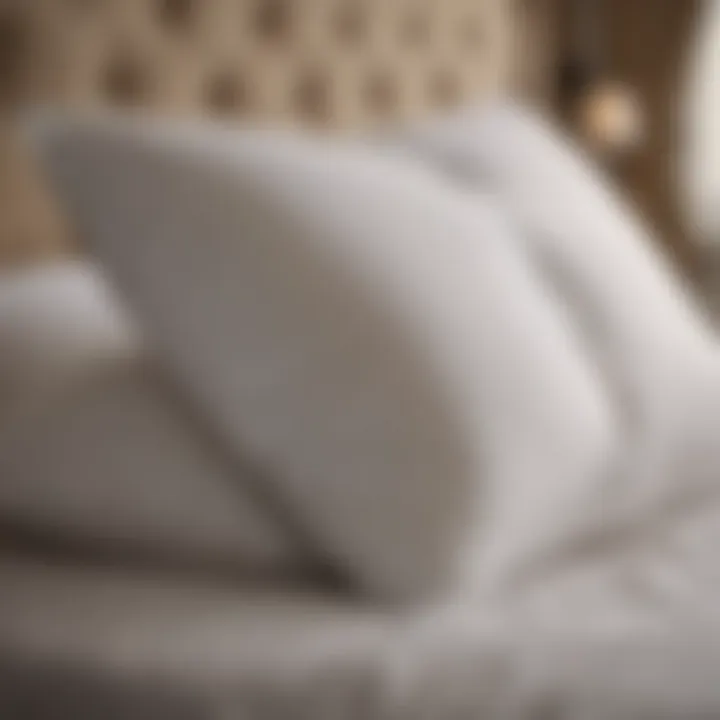
Intro
Goose down pillows can provide unmatched comfort and warmth in our beds, becoming a cozy sanctuary after long days. However, keeping them clean requires a bit of effort and understanding of their unique materials. This guide navigates the intricacies of washing these pillows, outlining methods that preserve their plushness and extend their lifespan. While many may think it sufficient to toss them into the washing machine and call it a day, this wouldn’t quite cut it. We’ll unravel the simple yet effective strategies to maintain these feather-filled wonders.
Why Clean Goose Down Pillows?
Over time, our pillows attract allergens like dust mites, sweat, and skin cells. Cleaning them not only enhances their appearance but also contributes to a healthier sleep environment. Regular washing can help to ensure that your pillows remain fluffy and resplendent. You might even improve the air quality of your bedroom by tackling the stubborn muck that accumulates. But it’s crucial to approach the cleaning process with care, as the down feathers require special treatment.
This comprehensive walk-through will cover key aspects of cleaning goose down pillows, including safe detergents, ideal washing techniques, and drying methods that help retain their loftiness. With understanding in hand, you'll feel empowered to refresh your bedding and ensure that your sleep experience remains as pleasant as possible.
Understanding Goose Down Pillows
When it comes to home textiles, goose down pillows have carved a niche for themselves, particularly in the realm of comfort and luxury. Not only do they provide ample support, they also enhance the aesthetic of any bedroom. Understanding goose down pillows is crucial for homeowners, interior design enthusiasts, and those who wish to maintain an inviting and cozy atmosphere in their living spaces.
What is Goose Down?
Goose down refers to the soft, fluffy feathers found under the outer feathers of geese. It serves as insulation, keeping these birds warm in colder climates. This material is prized for its lightweight properties and excellent insulation capabilities, making it an ideal filling for pillows and bedding. Unlike synthetic fillings, goose down offers a unique loftiness that creates a heavenly plush experience when resting.
The filling is sourced primarily from mature geese, as their down is superior in quality. It is important to note that the ethical procurement of down is a key consideration. Buyers should seek out brands that ensure humane treatment of birds during the harvesting process.
Benefits of Goose Down Pillows
Investing in goose down pillows comes with diverse benefits:
- Exceptional Comfort: The inherent fluffiness and softness of down provide a cushy feel, cradling the head and neck perfectly during sleep.
- Temperature Regulation: Goose down naturally adapts to body temperature, keeping you warm when it’s cold and cool when it’s warm—ideal for those jumping into bed after a chilly evening.
- Durability: Quality down pillows can last for many years with proper care. Well-maintained pillows do not lose their volume quickly, making them a wise investment.
- Lightweight Nature: Compared to other pillow materials, down is lighter, contributing to a more comfortable sleep experience.
However, it is also worth mentioning that some individuals may have allergies to down, which can lead to discomfort. Therefore, understanding your own needs is essential when considering feathered pillows.
Construction of Goose Down Pillows
The construction of goose down pillows contributes significantly to their performance and feel. Typically, these pillows are filled with pure down or a blend of down and small feathers. The ratio of down to feathers often dictates the quality and price of the pillow. Generally, higher down content results in enhanced loftiness and comfort.
The outer fabric, usually a cotton or cotton blend, also plays a key role. A high thread count fabric adds extra softness and durability, ensuring that the fluffy down stays contained and doesn't escape. Another element worth considering is the pillow's sewing method. Baffle box construction, for instance, allows for even distribution of fill, preventing clumping and promoting an even loft across the surface.
"Investing in quality goose down pillows can transform your sleep experience, making it as cozy as a night at a luxury hotel."
By diving into these details, you appreciate the artistry involved in making these pillows, providing a clearer picture of how they can enhance your nighttime routine. Not only do they support a good night’s rest, but they also serve as a focal point in your bedroom design.
Assessing the Need for Washing
Cleaning goose down pillows may seem like a mundane task, but acknowledging when and why it’s necessary can significantly prolong their life and overall comfort. Regularly assessing the need for washing is not just about maintaining appearance; it’s about ensuring health and hygiene within your sleep environment. Dust mites, allergens, and everyday wear can accumulate over time, even in the softest goose down. Ignoring this buildup can affect sleep quality and exacerbate allergies. Therefore, it becomes essential to periodically evaluate your pillows to determine if they are due for a cleanse.
Determining the Frequency of Cleaning
The frequency with which you should wash your goose down pillows depends on several factors. If you’re someone who tends to sweat during sleep or has allergies, a more frequent cleaning might be in order. On the other hand, those who sleep in a less humid environment can extend the intervals. A general guideline is approximately every six months, but this can vary:
- Allergy sufferers: Consider washing every two to three months.
- Regular usage: Every six months is typical.
- Low usage: Once a year may suffice.
It's beneficial to note that goose down pillows can be expensive, so being on top of maintenance makes them a good long-term investment. A simple assessment can save both your health and your wallet in the long run.
Signs Your Pillows Need Washing
Knowing when to wash your pillows is just as important as knowing how. Here are some telltale signs that it's time to give your goose down pillows a good wash:
- Odor: A musty or sour smell often indicates that your pillows retain moisture or have accumulated sweat and oils.
- Stains: Any visible stains from spills, sweat, or other mishaps are a clear sign that washing is necessary.
- Lumps or clumps: If you notice that the filling has started to clump together, this is likely due to accumulation of dirt or lack of air circulation.
- Allergies acting up: If you’re experiencing increased sneezing or allergic reactions during sleep, it’s time to inspect your pillows for dust mites and allergens.
"Your pillows should feel as good as they look. Regular washing ensures that they remain plush and free from unwanted guests like dust mites and stale odors."


In summary, being mindful about assessing your goose down pillows will not only keep them looking good but also create a healthier sleep environment. By maintaining a keen eye for signs of wear and understanding how often to wash based on your individual circumstances, you can ensure your pillows provide comfort for many nights to come.
Preparation Before Washing
Before diving into the actual cleaning of your goose down pillows, it’s pivotal to lay down some groundwork. Preparation before washing not only sets the stage for effective cleaning but also helps in preserving the quality and longevity of your pillows. This phase often goes overlooked, yet it’s crucial for ensuring that the right methods and materials are utilized, thereby safeguarding your investment.
Reading Care Instructions
Every pillow comes with a set of care instructions, usually found on the packaging or sewn into the pillowcase. Taking a moment to read these instructions can save you loads of headaches down the line. The specifics may vary depending on the manufacturer, but generally, these guidelines will tell you whether your pillows are machine washable or if they need to be cleaned by hand.
Sticking to the manufacturer’s recommendations helps in maintaining the pillow’s integrity. Factors like water temperature, detergent types, and washing cycles are covered under these instructions. Ignoring this step can lead to damaging your pillows, causing clumping or uneven fluffiness, which is not the kind of pillow fight anyone wants to have in their sleep.
Gathering Necessary Supplies
Now that you are familiar with the care instructions, it’s time to gather your supplies. Getting the right materials ready will ensure the cleaning process goes smoothly.
Mild Detergent
Mild detergent plays a central role in this cleaning process. It’s a gentle cleanser without harsh chemicals, making it an ideal choice for down pillows. A key characteristic of mild detergents is that they're less likely to strip the down’s natural oils. This characteristic is crucial since preserving these oils contributes significantly to the pillow's loft and softness.
A unique feature of many mild detergents is their ability to clean thoroughly without causing damage. They effectively eliminate dirt and grime without leaving any harsh residues behind. When searching for your detergent, make sure it doesn’t contain bleach or additional fragrances, as these can degrade the down material. While a popular choice, one downside of using mild detergents is their limited cleaning power for tough stains. This means pretreating those stubborn spots might be necessary.
Tennis Balls or Dryer Balls
Next on the list are tennis balls or dryer balls. These little helpers are indispensable during the drying phase. Their key characteristic is their ability to beat the pillows as they tumble in the dryer, which prevents clumping and maintains the fluffiness of the down. Using dryer balls can reduce drying time, which is another win.
The unique feature of using either type of ball is that they're essentially soft yet sturdy, meaning they won’t damage your pillows while providing the necessary agitation. The advantage of tennis balls is that they are readily available and often found in many households. A note of caution, though: avoid using them if you have any concerns about squeaking in the dryer.
Washing Machine Settings
Choosing the right washing machine settings is equally essential. The appropriate settings can vastly improve your cleaning efficiency while reducing the risk of damage to the pillows. Most likely, you’ll want to select a gentle cycle with cold water, as this will help preserve the delicate down material.
The notable aspect of washing machine settings is that they can vary based on the machine model. It’s wise to familiarize yourself with your washing machine’s specific cycles and options. An advantage of these gentle settings is that they use less agitation, which ultimately contributes to reducing wear and tear on the pillows. On the flip side, using incorrect settings, like hot water or aggressive cycles, may reduce the pillowy softness you’re aiming to maintain.
Overall, taking time to prepare before washing is about ensuring every step down the line contributes to a successful cleaning process. It enhances efficiency and helps in preserving the quality that makes goose down pillows such a sought-after commodity.
Washing Methods
When it comes to cleaning goose down pillows, understanding the various washing methods sets the stage for maintaining their fluffiness and longevity. Washing isn’t just a chore; it’s about ensuring the delicacy of the down insulation remains intact while getting rid of dirt, allergens, and unwanted odors. Instead of leaving the task to chance, a thorough cleaning process can extend the life of your pillows, keeping them cozy for years to come.
Machine Washing Goose Down Pillows
Whether you're short on time or just prefer a hands-off approach, machine washing is an efficient method for cleaning goose down pillows.
Choosing the Right Cycle
Selecting the most appropriate cycle plays a crucial role in preserving the integrity of the down. Generally, a gentle or delicate cycle is recommended for goose down pillows since it reduces agitation and minimizes the risk of clumping. This setting is a beneficial choice because it balances effective cleaning with care, making it popular among those who wish to protect their investment.
One unique feature of the gentle cycle is its slower spin rate, which helps prevent the down clusters from breaking apart. While it may take a little longer than a regular cycle, the trade-off is absolutely worth it. The downside? If you're in a hurry, it might test your patience.
Correct Water Temperature
Maintaining an appropriate water temperature is vital in this washing process. Using lukewarm water, ideally between 30-40°C (86-104°F), is often recommended. This temperature range is beneficial as it effectively cleans without risking damage to the delicate fibers of the down insulation. Hot water can be an enemy to many fabrics, potentially leading to shrinkage or setting stains.
One unique aspect of correct water temperature is how it can enhance the detergent's efficacy; lukewarm water opens the fibers, allowing for better penetration and cleaning. However, always avoid extreme temperatures, as they can lead to more harm than good.
Hand Washing Technique
For those who prefer a more tactile approach, hand washing presents a worthy alternative. This method allows for greater control over the cleaning process.
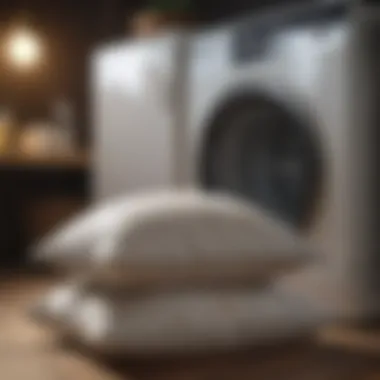
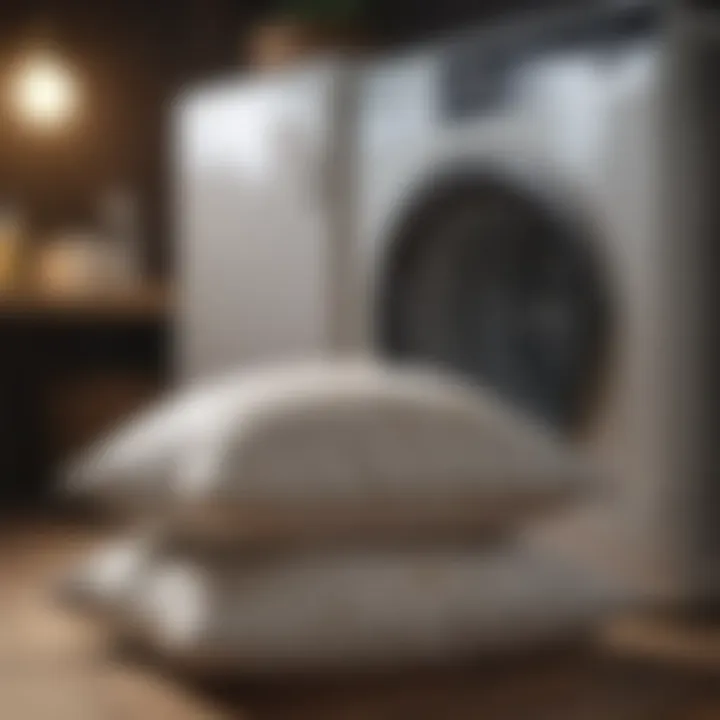
Soaking the Pillows
When opting for this technique, soaking the pillows is a significant step. Immerse the pillows in a tub filled with lukewarm water mixed with a mild detergent. This gentle approach works well in loosening dirt and debris without subjecting the pillows to harsh motions found in machines. This method might be preferred for those looking for a more detailed cleaning, ensuring every nook and cranny is attended to.
Additionally, soaking lets the detergent do its job efficiently over time, eliminating the hassle of repeated scrubbing. However, keep in mind that it can be a more time-consuming process.
Rinsing Procedure
Once you've soaked the pillows, it's important to thoroughly rinse them. Rinsing helps remove any soap residue that might linger and potentially cause irritation or affect the pillow's fluffiness over time. Ensure to do this gently; a simple method is to refill the tub with clean water and allow the pillows to float, gently squeezing and releasing them to expunge shampoo.
The benefit of this meticulous rinsing procedure is the assurance that no cleaning agent is left behind, thus keeping your pillows as fresh and lively as they should be. However, be prepared; this part may require some physical effort, as you may need to repeat the rinsing several times to achieve complete cleanliness.
Drying Process
The drying process is a critical stage when it comes to cleaning goose down pillows. After washing, ensuring that pillows are dried properly is essential for maintaining their structure, softness, and thermal efficiency. Improper drying can lead to clumping, unpleasant odors, or even mildew buildup, all of which can compromise the integrity of your pillows. Understanding the best techniques for drying can save you time, enhance your comfort, and prolong the life of your pillows.
Proper Drying Techniques
Using a Dryer
Using a dryer is one of the most popular methods for drying goose down pillows. This approach can be extremely effective, primarily because of the consistent heat and airflow provided. In fact, a tumble dryer equipped with a low-heat setting can do wonders. The main characteristic that makes this method stand out is the ability to fluff up the down fill as it dries.
With the addition of dryer balls or tennis balls, you not only minimize clumping but also encourage air circulation within the pillow. These items effectively circulate the down, helping it regain its natural fluffiness as it removes moisture. However, it’s important to keep an eye on the drying process, as overheating can lead to damage – a classic case of ‘too much of a good thing.’
Some advantages of using a dryer include:
- Speed: Drying in a machine can take a fraction of the time compared to air drying.
- Efficiency: Even moisture distribution helps retain the pillow's integrity.
However, you have to be cautious. The high temperatures can be detrimental if not monitored carefully.
Air Drying Methods
On the flip side, air drying methods can be seen as a gentler alternative. If you have the time and space, hanging goose down pillows outdoors on a sunny, breezy day could work wonders. This method allows for natural evaporation of moisture, thanks to good airflow and sunlight, which also has a disinfectant effect.
A key trait of air drying is the minimal risk of damage to your pillow's fabric and fill. It’s a popular choice among those who favor eco-friendly practices and want to avoid the potential hazards of using a dryer. The unique feature of air drying lies in its ability to breathe new life into your pillows through natural elements.
Pros of air drying include:
- Eco-Friendly: It doesn't consume electricity, making it a greener alternative.
- Gentleness: It's less likely to cause any wear and tear on your pillows.
However, there are some downsides as well. The process can take a significant amount of time, which might not be feasible for everyone. You also need to ensure that the pillows are placed in a space where they can dry evenly to prevent any musty smells from developing.
Avoiding Clumping
Clumping is a common concern when dealing with goose down pillows. During both the washing and drying processes, the down can become bunched up, leading to uneven support and fluffiness. To prevent this, consider the following tips:
- Use Dryer Balls: As previously mentioned, adding dryer balls can help separate the fill as they agitate the pillow in the dryer.
- Check for Dryness: Don’t just rely on a timer; check to make sure the pillows are completely dry to avoid clumps forming later.
- Fluff Regularly: Periodically fluff the pillows during the drying process to encourage even drying.
By being mindful of these drying techniques, you can effectively maintain the quality and comfort of your goose down pillows. Proper care during this phase ensures that your investment in bedtime comfort remains worthwhile.
Maintaining Goose Down Pillows
Keeping goose down pillows in their prime requires more than just the occasional wash. It's about fostering a routine that not only extends the life of these luxurious bedding accessories but also enhances their comfort and function. Down pillows are known for their remarkable softness and resilience, making maintenance essential.
Properly maintained pillows help trap warmth, regulate moisture, and maintain their fluffiness. By giving your pillows the attention they deserve, you ensure a night’s sleep that feels like resting on a cloud. Regular maintenance can stave off accumulations of allergens, dust mites, and odors that, if left unchecked, can lead to discomfort. Keeping your bedding fresh is key—it's more than aesthetic; it’s about health too. Let’s dive into some practical tips to keep those pillows in tip-top shape.
Regular Maintenance Tips

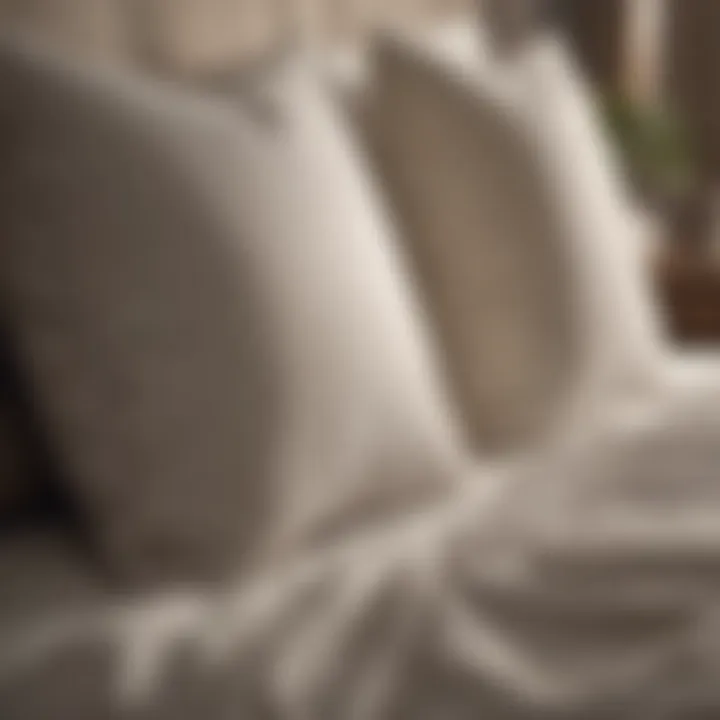
Regular checks and light practices can keep your pillows fresh for longer periods. Here are some simple yet effective ways to integrate maintenance into your routine:
- Fluff Daily: Give your pillows a gentle fluff each day. This redistributes the down inside, preserving their shape and comfort.
- Air Them Out: Whenever the weather’s nice, let your pillows breathe outside. A few hours in fresh air can help reduce odors.
- Spot Clean Stains: Don’t wait for a full wash if there are minor stains—attending to them promptly can prevent bigger cleaning tasks later.
These tasks might seem small, but they add a considerable amount of longevity and comfort to your down pillows.
Proper Pillow Protection
Use of Pillow Protectors
Investing in pillow protectors is a wise step in preserving the quality of your down pillows. These covers act as a barrier against spills, sweat, and dust. With protectors, you’re extending the life of the down filling. Not only do they act as a shield, but some are also designed to be moisture-wicking or hypoallergenic. This can be particularly beneficial for those with allergies or sensitive skin.
One standout feature of pillow protectors is their ability to prevent feathers or down from escaping. This is crucial, as it maintains the plushness you expect from your pillows. However, it’s essential to ensure that the protector allows for some breathability; otherwise, you could risk overheating while you sleep.
Storage Recommendations
When it comes time for seasonal storage, down pillows need special attention. Keeping them stored properly can prevent permanent deformation and mold growth. Ideally, they should be kept in a breathable cotton bag or a large pillowcase. This will protect against dust without trapping moisture. Avoid plastic bags, which can suffocate the down and lead to mildew.
An important characteristic of proper storing is to keep them away from extreme temperatures and humidity. This especially resonates if you live in a climate where humidity is an issue. Over time, improper storage can lead the down to clump together, reducing their fluff and comfort.
For the discerning homeowner, taking the extra time to maintain goose down pillows pays dividends in comfort and longevity, allowing you to enjoy a restful night sleep for years to come without compromise.
Troubleshooting Common Issues
When it comes to cleaning goose down pillows, even the best-laid plans can run into a few bumps in the road. Issues might pop up during or after the cleaning process, and knowing how to address them is vital for maintaining the integrity and comfort of your pillows. This part delves into the common problems you might face and offers guidance on how to remedy them effectively.
Dealing with Odors
Odors can sneak into your goose down pillows, often from a mixture of perspiration, natural oils from your skin, and even humidity in the air. It’s a nuisance that can turn your cozy sleeping space into a less-than-pleasant environment. If you notice an unwelcome smell lingering around, don't panic. There are straightforward remedies that can help.
First, let’s discuss prevention. It’s wise to air out your pillows regularly—just about once a month. Let them bask in the sunlight for a few hours. This not only enhances freshness but also kills off any microscopic critters that may have taken residence.
If your pillows already smell, consider this approach:
- Baking Soda: Sprinkle a generous amount on the pillow’s surface, let it sit for a few hours, and then vacuum it up. Baking soda works like a charm by absorbing the odors.
- White Vinegar Spray: Mix equal parts of water and white vinegar in a spray bottle. Lightly mist the pillows (don't soak them!) and let them air dry. The vinegar smell dissipates quickly, taking the unwanted odors with it.
These methods can go a long way to ensuring your goose down pillows stay as fresh as a daisy for a long time.
Restoring Volume and Fluffiness
Another issue that often crops up is the flattening of pillows, which can happen after washing. While goose down pillows have that luxurious loft that many adore, improper care can make them lose their shape, leaving you with a sad pancake of soft fluff. Thankfully, there’s hope to bring back their vaunted volume.
The first step is to make sure your pillows are completely dry. Damp feathers can lead to clumping and odors. If you're drying them in a machine, add some tennis balls or dryer balls. This helps break up clumps and allows air to circulate, restoring the fluffiness.
If you're stuck with pillows that still feel flat:
- Punch It Up: Once dried, give them a good shake and a few punches. Sounds a bit odd, but this can help redistribute the down to create that heavenly volume once again.
- Fluffing Method: Place your pillows in a large dryer on a low-heat cycle without any other laundry. The gentle tumbling will help revitalize the down.
By addressing odors promptly and restoring fluffiness, you're investing in a more pleasurable sleeping experience. Goose down pillows aren't just bedding; they're little clouds of luxury that deserve the best care.
End
Cleaning goose down pillows is not just a housekeeping chore; it’s a vital practice that can significantly prolong the life and comfort of one’s bedding. A clean pillow is directly linked to better sleeping conditions, affecting both health and quality of rest. Through regular cleaning, you can keep allergens at bay, dissipate unpleasant odors, and ensure a fresher, fluffier pillow to cradle your head at night.
Final Thoughts on Cleaning Goose Down Pillows
Considering the investment usually made in high-quality goose down pillows, maintaining them should not be taken lightly. It's essential to understand the unique properties of down; they require a tailored approach to washing and drying to avoid damage.
In essence, paying attention to care instructions, using appropriate cleaning supplies, and being mindful during the drying process play a role that cannot be overstated. Every step taken—from choosing the right detergent to employing the best drying method—adds to a pillow’s longevity and comfort.
"Keeping your down pillows clean is like giving your sleep a luxurious upgrade. It’s that simple and effective!”
Maintaining cleanliness can be a straightforward process, yet it carries long-term benefits that yield a sleeping experience unlike any other. A well-stewarded pillow can offer not only good night’s sleep but also add a touch of elegance and warmth to your bedding ensemble.
Embrace this essential practice and transform your sleep space. After all, a clean pillow isn’t just about aesthetics; it’s about nurturing your well-being, reaffirming the investment in quality textiles, and enjoying a sanctuary of comfort night after night.















